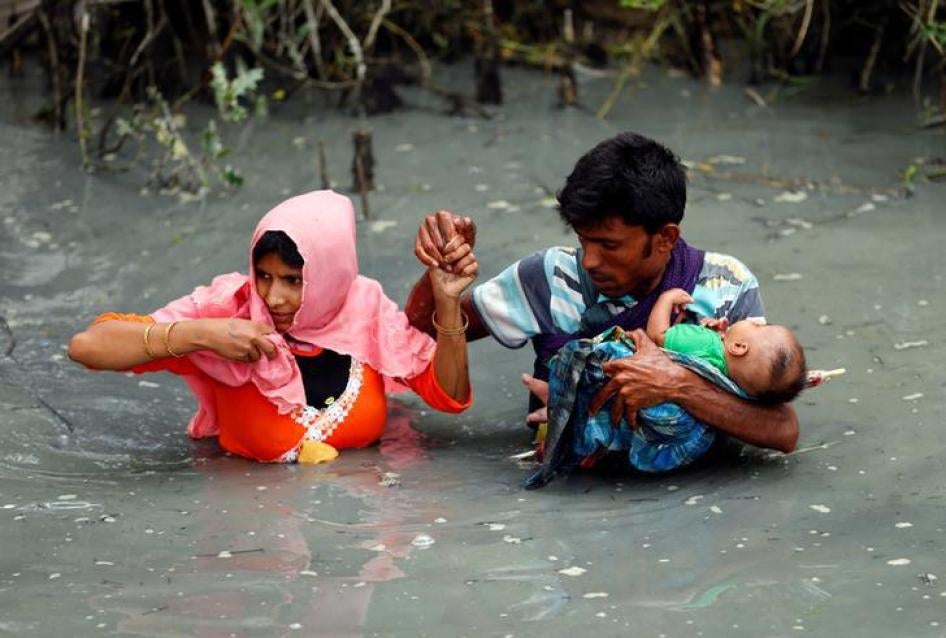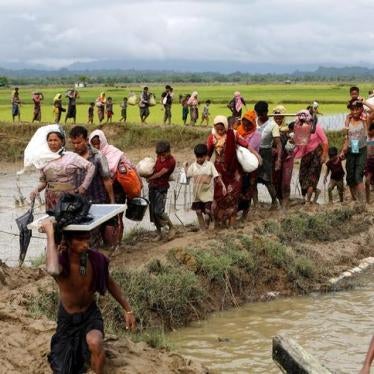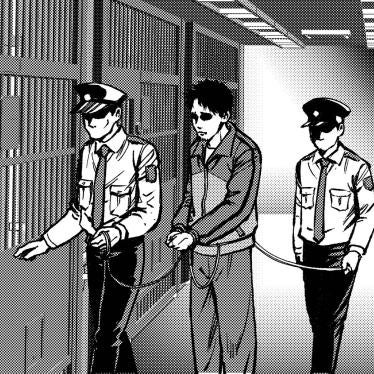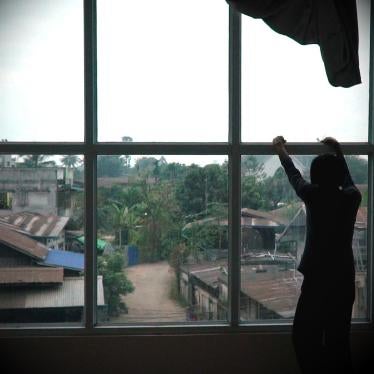(ニューヨーク)― 政府治安部隊から逃れてきたビルマ・ラカイン州に住むロヒンギャの人びとは、村での殺害や砲撃、砲火の様子を語った。これらはまさに「民族浄化」作戦の決定的な証拠だと、ヒューマン・ライツ・ウォッチは本日述べた。
ビルマ国軍と警察、ラカイン民族の武装集団は、アラカン・ロヒンギャ救世軍(ARSA)が警察や軍施設など約30カ所を襲撃した2017年8月25日以降、ロヒンギャが集住する村への作戦行動を実施している。ビルマ国軍司令官ミンアウンフライン上級大将はマスコミに対し、国軍によるラカイン州での掃討作戦は政府が認めたものであり、第二次大戦にさかのぼる「未完の仕事」だと述べた。
国連安全保障理事会は、公開の緊急会合を開き、ビルマ当局に対し、ロヒンギャ住民への残酷な作戦を停止しなければ、重い制裁措置の対象になるとの警告を発するべきだ。
「ロヒンギャ難民は、自分たちがいかにビルマ軍の襲撃から逃れ、村が焼き討ちに遭ったかについて悲惨な経験を語っている」と、ヒューマン・ライツ・ウォッチの南アジア部長メナクシ・ガングリは述べた。「地元住民の自宅を焼き払って追い出すことは、武装集団に対する合法的な作戦の一環ではない。」
9月上旬、ヒューマン・ライツ・ウォッチは国境のバングラデシュ側に逃れたロヒンギャ難民50人以上に話を聞くとともに、10人ほどから詳細な証言を収集した。インタビューに応じたロヒンギャの人びとはヒューマン・ライツ・ウォッチに対し、ビルマ政府治安部隊は村人に武装襲撃を行い、住民に銃や刃物で傷を負わせ、住宅に火を放ったと述べた。国軍が襲撃時に小火器や迫撃砲、武装ヘリコプターを使った様子も語られた。
ヒューマン・ライツ・ウォッチは、ラカイン州北部(ラテーダウン、ブティーダウン、マウンドーの3郡)での広範な火災と一致する、衛星データと衛生写真を入手した。現在までにヒューマン・ライツ・ウォッチは、衛星に搭載した熱感知技術がかなり広範囲な火災を捉えた地点を21カ所確認している。バングラデシュの消息筋はヒューマン・ライツ・ウォッチに対し、国境に隣接するビルマ側の複数の村で、重・軽機関銃の銃声と迫撃砲の発射音がはっきり聞こえたとし、その直後にこれらの村で煙が上がったのを見たとも述べた。
ビルマ政府は治安部隊の人権侵害を否定しつつ、死者約400人(大半がロヒンギャ武装勢力とされる人びと)に上る対テロ軍事作戦に従事していると主張する。ビルマ当局は根拠を一切示さず、武装集団とロヒンギャ現地住民がラカイン州北部60カ村で家屋6,845棟に放火したと発表した。難民の証言はこうしたビルマ当局者の主張と相容れないと、ヒューマン・ライツ・ウォッチは指摘した。
たとえば、マウンドー郡のモメナさん(32、女性)は8月26日にバングラデシュに逃れた。治安部隊に村を襲撃された翌日のことだ。村に兵士が来たので子どもと隠れたが、それから戻ってみると、子どもや老人を含め、村人40~50人が殺害されていたという。「それぞれに刀創か銃創があり、両方ある人もいました。父も亡くなっていました。首のところがばっくり割れていました。父親を弔うこともできないまま逃げました。」
バングラデシュ側国境の町コックス・バザールの病院で、ヒューマン・ライツ・ウォッチは銃創のある複数のロヒンギャに話を聞いた。自宅で撃たれたという人もいれば、村から逃げているとき、あるいはビルマ兵から逃れて野原や丘に隠れているときに撃たれたという人もいた。
ウスマン・ゴニさん(20、男性)は襲撃を受けた際、友人5人と村の外の丘で家畜の世話をしているところだったという。ヘリコプターが頭上を飛んでいると思ったら、何かが落ちてきた。あとでそのヘリコプターが落とした何かに当たったのだと気づいたという。友人のうち4人がその破片で受けた傷で落命し、ゴニさん自身は村人によってバングラデシュ側まで運ばれて治療を受けたという。ヒューマン・ライツ・ウォッチが病院で話を聞いた時点では、胴体にある破片はまだ取り除かれていなかった。
ラカイン州の現状に対するヒューマン・ライツ・ウォッチのこれまでの調査結果は、民族浄化作戦の存在を示している。国際法に「民族浄化」の正式な定義はないが、国連の専門家委員会は1994年にこの単語を「ある民族または宗教集団が、暴力的で恐怖を惹起する手段を用いて、別の民族または宗教集団を一定の地域から排除する意図的な政策」と定義し、「その目的は追放された単数または複数の集団の排除による領域の占有にあると思われる」と記している。
「私たちなどが明らかにしている、ラカイン州でのおぞましい事態が停止に向かっているとの兆候はない」と、前出のガングリ部長は述べた。「国連と関係国は直ちにビルマに働きかけ、ロヒンギャ帰還に向けた第一段階として、ロヒンギャへの一連の恐るべき人権侵害を止めるよう求めるべきだ。」
ラカイン州マウンドー郡の村々への攻撃について(バングラデシュに逃れたロヒンギャ難民とのインタビュー<8月30日~9月5日>より)
Yasin Ali
Yasin Ali, 25, said that Burmese security forces attacked his village of Reka Para on August 27. Prior to the attack, tensions had been building in Reka Para and neighboring Rohingya villages as local Rakhine harassed and abused them for months. Ali said: “They would come around to us and say, ‘This is not your land. Don’t cultivate this land, and don’t dare take the food growing on it.’ If we went near their lands, they would beat us with sticks.”
During the August 27 attack, all the villagers went into hiding. Ali said the women and children were sent further away to seek shelter, while the men stayed close by to wait out the attack in the hopes that they could quickly return to the village after the soldiers left. He said he hid by the roadside, about half a kilometer from where the soldiers made their approach. He heard what sounded like mortar shells hitting the village: “I heard boom boom boom, and then I saw the houses just collapse.” After a while, he saw the soldiers advance toward the village, and from his vantage point, he saw that they were carrying small arms and what looked like light machine guns. He also said he saw a mortar system on the shoulder of a soldier, and some apparent mortar rounds the size of a grapefruit.
Ali said that when the soldiers entered the village, they started shooting indiscriminately. He and the other men from the village then decided to run away into the hills for shelter. From the hills, he saw a helicopter painted olive green circle his village four times, and saw something being dropped from the helicopter after which the houses in the village caught fire.
Ali and his family walked to Bangladesh and were allowed to enter by the border guards. They arrived on August 31, and at the time Ali spoke with Human Rights Watch, they were waiting outside trying to sort out where they could get shelter.
Momena
Momena, 32, fled her village of Kirgari Para on August 26 with two of her three children. She said that soldiers had previously attacked the village during the military operations in late 2016, but the situation in her village had settled down since then. She described the events that prompted her to flee:
I heard the sounds of fighting around 4 p.m. on Friday [August 25]. There was a lot of noise, worse than before. I saw them [the soldiers] myself as they entered my village. I don’t know how many there were but it looked like a lot to me. I fled with the other villagers and we sheltered in the jungle overnight. When I returned to the village the next morning, after the soldiers had left, I saw about 40 to 50 villagers dead, including some children and some elderly. All had knife wounds or bullet wounds – some had both. My father was among the dead; his neck had been cut open. I was unable to do last rites for my father, I just fled.
Momena said she had to leave her husband and 10-year-old son behind. She has had no news of them since then. Her husband has no mobile phone and other villagers she is in contact with have heard no news of either of them. She heard that her mother is alive but has no idea where she is or how she is.
From her vantage point while hiding in the jungle, Momena said she could see some of the houses in her village burning at night. She believes soldiers set fire to the houses as a warning to the villagers.
Momena said she did not know of any armed Rohingya militants in the village. She had heard some youth in the village talking about resisting, but she never saw anyone take any action on this, there was just talk. She said many young Rohingya men fled into the jungle after the attack.
In addition to bodies found in her village, Momena said she saw several bodies of children in the Naf River at one of the crossing points into Bangladesh.
Momena said that when she and others fleeing with her crossed into Bangladesh, the Bangladesh Border Guards stopped them and said: “We have to stop you but if you shout and insist on entering, we’ll let you in.” She understood this as the guards pretending to obey their orders to refuse refugees entry to Bangladesh, but in practice helping the refugees enter the country.
Khatija Khaton
Khatija Khaton, a widow, lived in the village of Ashikha Mushi with her four children. She said that on August 25, an armed group of ethnic Rakhine youth came to her house and issued vague threats. She recognized them from previous encounters because most of them had been involved in the violence against her community in October 2016.
Khaton said she had never reported previous threats because “We don’t trust the police, we just escape, that’s our only solution.”
The youth were armed with rifles and slingshots. She heard periodic gunshots, and other villagers said that the army was helping the Rakhine youth, but she did not see any evidence of that herself.
After seeing the armed Rakhine group kill a young Rohingya man, a 22-year-old called Rahim, she decided to leave her village that day after Friday noon prayers. She said that initially the Rohingya youth in the village responded to the Rakhine group’s show of armed strength and threats by protesting with bamboo poles, but the Rakhine group opened fire on them:
Jumma prayers were just over that Friday, and the men and boys were outside the mosque when the Rakhine armed men came up to them. Rahim and others took up bamboo poles, that’s all they had, but Rahim panicked when they began to shoot. He started running away. I saw them shoot him – the bullet went through his cheek, right by his cheekbone under his eye. He died from that wound.
After witnessing that shooting, Khaton panicked and fled into the hills with her three teenage daughters, ages 13, 15, and 18, whose safety she most feared for. She left her 5-year-old son behind – many Rohingya thought younger children might be safe from attack – but since then, she has no news of him.
She learned that the armed Rakhine group had returned to attack her village in the early hours of August 26. While hiding in the hills, Khaton said she saw several helicopters. She also said she heard bombs being dropped near and around her village: “It was a constant boom boom boom.” She saw her village mosque and one house in her village burning.
Khaton and her daughters had no trouble entering Bangladesh, but she remains concerned about the security of her daughters, and is troubled by uncertainty and guilt for her young son left behind.
Nurus Safa
Nurus Safa, about 40, fled from Fahira Bazar in the village tract of Kha Maung Seik on August 29. She appeared to be in a state of shock when Human Rights Watch met her less than 24 hours after she arrived Bangladesh. “Many people were killed by knives, houses burned,” she said. “We were threatened, people were wounded, so I just fled.”
Safa said her village was attacked on August 25 by men in uniform whom she assumes were Burmese army soldiers. She and other villagers ran from the village and hid in the nearby hills for a few days and nights. She had heard rumors that some Rohingya youth in her village had been arming themselves and organizing protests, but she did not know this directly and had seen no signs of it.
In her panic to leave, Safa left behind the three eldest of her six children, ages 7, 8, and 15. She has received no news about them or her husband, Shafique Ahmed. She said that when she crossed the Naf River, the water level was up to her neck because of heavy monsoon rains. She said she saw many wounded people crossing the river into Bangladesh, but does not know who they were or how they were injured.
Safa says she and her younger children did not have any trouble from the Bangladeshi border guards when entering Bangladesh.
Mohammad Yunus
Mohammad Yunus, 26, said his village of Sikadir Para in Tat U Chaung village tract, close to the border with Bangladesh, was attacked on August 26. Although the villagers had had no prior warning of the attack, they were nervous because other people had come to his village fleeing attacks on their own villages further inland. He described the attack on the neighboring village of Falinga Ziri:
I remember army helicopters, olive green in color, flying around. I was standing on the other side of a canal, watching all this happen directly across from me. I was very close and saw it all myself. The soldiers were using guns that shoot fire, or something that explodes and sets fire.
Yunus was not sure how many soldiers were involved in the operation, but he thinks there might have been over 250. He said he saw about 25 to 30 houses set on fire in Falinga Kiri from his vantage point. He said that at the time of the attack, it looked to him like there were no villagers left; they had all fled earlier.
Yunus and his fellow villagers quickly decided to flee their village as well. The next day, August 27, as they were heading toward shelter in neighboring hills, he saw soldiers and police shooting at villagers fleeing. He learned later that one woman had been killed.
Yunus said that he did not know of any Rohingya men who had been training or arming themselves, or had engaged in any militant activity.
Begum Bahar
Begum Bahar said that soldiers attacked her village of Kun Thee Pyin on August 25. They wore olive green uniforms and she believes they were Burmese army. She along with seven of her children and other villagers fled in panic when they saw the soldiers and heard gunfire. They ran into the jungle to cross the border into Bangladesh for safety, a two-hour walk away.
Bahar said she saw at least three bodies as she fled to the border crossing. One had a cut on the back of the neck and two suffered from bullet wounds. She heard the “boom boom boom” of large weapons firing all day August 26 and 27, as she was attempting to cross the Naf River into Bangladesh. During the river crossing, she lost contact with her 12-year-old son and does not know if he survived.
Begum Behar said she was unaware of Rohingya militant training or anti-government activities. She said that the authorities had ordered all Rohingya villages to deposit sharp weapons to local leaders to turn over to the police, so any kind of resistance would be difficult. She did admit that her 22-year-old son had opposed her decision to leave and stayed behind when she left with her other children.
Tabarak Hussein
Hussein, 19, said that on August 27 at about 9 a.m., about 200 to 300 Burmese security forces in uniform along with local Rakhine men arrived at his village of Kun Thee Pyun (Kwashong in Rohingya). He said they were all armed, but was too frightened to have a proper look at their weapons. They began a spree of indiscriminate shooting in the village.
Hussein said that before the attack, tensions had been running high:
The local police had been harassing us, mistreating us for at least six months before this. They would take away our cows, for example. We were angry about this but we didn’t protest; we knew protesting would come to nothing. Then on the Friday [August 25] before the attack, four people were killed in my village [by the police]. I don’t know exactly how it happened. They were all Rohingya men. We left the village that day and hid in the hills, but came back because the police seemed to back down and leave. We thought it was all over, but it was not.
Hussein said that when the August 27 attack began, he and the other villagers fled into the hills. From atop one hill, he saw a helicopter flying over Kun Thee Pyun village, and then almost immediately after he saw houses in the village catch on fire. He doesn’t know what caused the houses to catch fire.
He said that none of the villagers in his village were killed or injured during the August 27 attack. He walked for two days and on August 29 arrived at the Bangladeshi border. He said the Bangladesh border guards stopped his group at the border for a while, and then instructed them to take another route to enter Bangladesh. The group did that and they were allowed in.
Anwar Shah
Anwar Shah, 17, said that on the morning of August 27, Burmese security forces in uniform opened fire on a crowd in his village of Let Ya Chaung, killing three Rohingya men and a boy, and wounding 18 others. He said he didn’t know the circumstances of the shooting, but there had been tensions between the authorities and local Rakhine and Rohingya villagers for some time. He didn’t think the four were armed or posed any security threat. The dead included Shah’s brother, Abdu Satter, 22. Abdu Shukur, about 50, Nur Alam, about 15, and Haroun, about 25. Their families buried them in the neighboring village of Kum Para because they were too frightened to bury them in their own village.
Shah said that after the attack he saw the local village mosque was on fire. He heard that the local police were responsible setting the blaze but did not witness that.
Shah said that following his brother’s death, he fled to Bangladesh. He learned that there was a big attack on his village the next day, August 28, and that all houses were set on fire.












